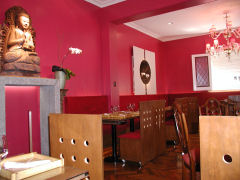
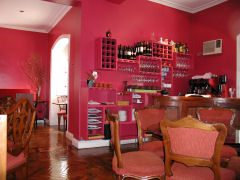
Buenos Aires – When I first saw the name I thought it was a play on the famed nightclub, but after dining, and meeting the owner, realized that Buddha BA was more of a spiritual kinda thing. Located at Arribeños 2288, in Barrio Chino, this two-story “resto-bar” also includes a separate tea salon, a tranquil garden, and an art gallery. It’s a shame that food isn’t served outside in the garden, just tea, but the vermillion dining room is very comfortable, and the service delightful. [Closed in 2019, replaced by a Cantonese restaurant, Yüt]
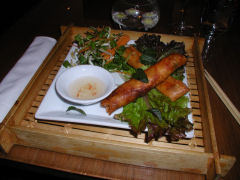 The food is a blend of various Asian cuisines, not “fusion” in the way we often think of it, really more of individually creative twists on classic dishes. A perfect example, my starter, the Paté Imperial, starts with what is probably my favorite Vietnamese appetizer, cha gio. Typically these springrolls are served hot and crispy; which you eat by wrapping them in mint, cilantro, shredded vegetables, and a lettuce leaf; and then dipping the whole thing in a sweet and sour fish sauce. The basic idea at Buddha BA is the same, but the big twist is the filling. Instead of the usual minced pork, shrimp, mushrooms and sprouts, the chef here takes another Vietnamese “classic,” usually just referred to as a Vietnamese Sandwich, and fills the springolls with a mix of roasted pork, paté, and spices. The wrapping process is the same, though sans cilantro, the sauce is a clean and vibrant rice vinegar edged with fiery chilies. Quite probably the best cha gio I’ve ever had.
The food is a blend of various Asian cuisines, not “fusion” in the way we often think of it, really more of individually creative twists on classic dishes. A perfect example, my starter, the Paté Imperial, starts with what is probably my favorite Vietnamese appetizer, cha gio. Typically these springrolls are served hot and crispy; which you eat by wrapping them in mint, cilantro, shredded vegetables, and a lettuce leaf; and then dipping the whole thing in a sweet and sour fish sauce. The basic idea at Buddha BA is the same, but the big twist is the filling. Instead of the usual minced pork, shrimp, mushrooms and sprouts, the chef here takes another Vietnamese “classic,” usually just referred to as a Vietnamese Sandwich, and fills the springolls with a mix of roasted pork, paté, and spices. The wrapping process is the same, though sans cilantro, the sauce is a clean and vibrant rice vinegar edged with fiery chilies. Quite probably the best cha gio I’ve ever had.
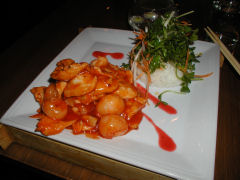 The followup take on a classic Chinese sweet and sour chicken was not quite as awe-inspiring, but was still excellent. Besos de paupé, which I think translates as “pauper’s kisses,” was a nice mound of lightly sauteed white meat chicken and litchis. The saute is then coated in a sweet and sour sauce that is based on tomato and carrot, with just a little bit of litchi juice added. The sauce is, perhaps, a touch cloying, but I can’t say that that really surprised me given the description of the dish as a sweet and sour with litchis . . . and it was served with just enough white rice and a bit of a salad of mixed sprouts.
The followup take on a classic Chinese sweet and sour chicken was not quite as awe-inspiring, but was still excellent. Besos de paupé, which I think translates as “pauper’s kisses,” was a nice mound of lightly sauteed white meat chicken and litchis. The saute is then coated in a sweet and sour sauce that is based on tomato and carrot, with just a little bit of litchi juice added. The sauce is, perhaps, a touch cloying, but I can’t say that that really surprised me given the description of the dish as a sweet and sour with litchis . . . and it was served with just enough white rice and a bit of a salad of mixed sprouts.
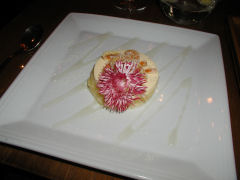 Of course, when I’m impressed with the rest of the meal, I can’t say no to dessert. The Lima Tang Kao was fantastic. “Tang kao,” I believe, is more or less just the Chinese term for desserts, tang being sugar and kao meaning baked. “Lima,” depending on which Spanish speaking country you’re from, can be either lime or lemon. For some reason that I’ve never understood, lima and limón get switched around in different cultures, with the latter seeming to refer to whichever one is more common locally. The description of the dessert was a “lime cake with lemon syrup,” how could I pass that up? It was beautifully plated with a pink crysanthemum (which I was warned was decoration only), an intense lemon syrup zig-zagged on the plate, the “cake” was a thin layer of a shortbread crust, topped with a thick layer of lime curd, topped with a thin layer of lime infused, gelled sour cream and candied lemon peel. As I said, fantastic!
Of course, when I’m impressed with the rest of the meal, I can’t say no to dessert. The Lima Tang Kao was fantastic. “Tang kao,” I believe, is more or less just the Chinese term for desserts, tang being sugar and kao meaning baked. “Lima,” depending on which Spanish speaking country you’re from, can be either lime or lemon. For some reason that I’ve never understood, lima and limón get switched around in different cultures, with the latter seeming to refer to whichever one is more common locally. The description of the dessert was a “lime cake with lemon syrup,” how could I pass that up? It was beautifully plated with a pink crysanthemum (which I was warned was decoration only), an intense lemon syrup zig-zagged on the plate, the “cake” was a thin layer of a shortbread crust, topped with a thick layer of lime curd, topped with a thin layer of lime infused, gelled sour cream and candied lemon peel. As I said, fantastic!
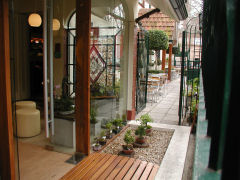 Buddha BA is big on tea service, and as I mentioned has a separate tea salon and garden. The selection is available in the dining room, and my waitress enthusiastically recommended the té rojo de Yunnan, or red tea from Yunnan province. It definitely provided great counterpoint to the dessert. I also liked the tea service – the tea is fresh brewed in a small earthenware pot, then timed, and when ready, strained into a small ceramic pitcher at tableside and served with delicate little teacups. Not an elaborate ceremony, but a nice touch.
Buddha BA is big on tea service, and as I mentioned has a separate tea salon and garden. The selection is available in the dining room, and my waitress enthusiastically recommended the té rojo de Yunnan, or red tea from Yunnan province. It definitely provided great counterpoint to the dessert. I also liked the tea service – the tea is fresh brewed in a small earthenware pot, then timed, and when ready, strained into a small ceramic pitcher at tableside and served with delicate little teacups. Not an elaborate ceremony, but a nice touch.
Black tea comprises about 78% of the entire world’s total tea consumption. Black tea, or as it is known in China – hong cha (red tea), was originally only for export to the foreign markets. In China it is called red tea in reference to the color of the infused liquid or to the red edges of the oxidized leaves, as opposed to the color of the main body of the processed tea leaves. At one time, black tea was considered of lesser quality and not desired by the Chinese themselves and therefore, was exported. Which is why, to this day, black tea is what everyone outside of China thinks of when talking about tea, whereas, tea in China is understood to mean green tea.
Yunnan, “Cloud South” (or South Cloud), the mountainous southern Province that borders Vietnam, Laos, Burma, and Tibet that is thought to be the “origin” of the tea plant (Camellia sinensis). There is one wild tea plant there that is over 100 feet tall and estimated to be about 1700 years old! Of the 320 subvarieties of tea plants in China, Yunnan is home of 260 of them.
Dan,
Can you give me an idea of the cost of this meal. You make it sound fantastic, as I’m sure it was
Jerry King
For the three courses, plus a bottle of water and a cup of tea, if I remember right it was 32 pesos, or between $10-11.
It really is a pretty special place, I was just recommending it to some friends last night. Worth the trip to an out of the way neighborhood!
[…] All around assessment, Green Bamboo is fine, and an okay place to get a fix here when you want something more or less resembling Vietnamese food. I’ve heard that Sudestada, another nearby location, is better, and that’s on my list to checkout as well. I think the creative pan-asian creations at either Buddha BA or Osaka, while not specifically Vietnamese, are far more interesting, as are the venues. […]
[…] Overall, I liked the place. I might give it a few more points than I gave Green Bamboo just for creativity; but then, Green Bamboo’s food definitely has a more Vietnamese focus and traditional style. For really good creative Asian food and quality I’ll still stick with BuddhaBA or Osaka. By the way, the owner of Sudestada has just opened up a second restaurant kitty-corner from his first, called Standard, serving “Argentine comfort food of the ’50s and ’60s”. I’ve added it to my list to try. […]
[…] Buenos Aires – Apparently, Monday is the Sunday of Chinatown here. Who knew that virtually every single restaurant in Barrio China is closed on the day of the moon? Met up with my friend Heather, planning on a lovely lunch at BuddhaBA it was closed, so was Siempre Verde, in fact, there were only 2 restaurants open on the entire strip that we saw. Even nearby Contigo Peru, for a casual Peruvian lunch, was shuttered for the day. Neither of the two open options looked overly exciting, but one of them at least had Chinese people eating in it, 3 or 4 of them anyway. Thankfully, Dragon Porteño Arribeños at Arribeños 2137, turned out to be a decent option. […]
[…] Buenos Aires – I received several e-mails from people asking me about fresh litchis (also lychees or laichis). I forget sometimes that having spent twenty plus years in New York City, most of it in restaurants, that much of what I take as commonplace is unusual or exotic for many people. A lot of folks had tried them in Chinese restaurants, sometimes in a sweet and sour dish, sometimes as part of some sort of fruit dessert. But that’s different than both seeing and eating them fresh. […]
[…] Buddha BA – Mixed Chinese and southeast Asian cuisine, and not on the same plate, just a good number of options. Great service, delicious food, beautiful, tranquil atmosphere. This spot is still my favorite. You won’t be able to have a complete Thai, or Vietnamese, or other meal with a couple of dozen different choices from one cuisine, but you will be able to pick and choose and suit a variety of palates. The one thing lacking, there’s not a single truly spicy dish on the menu – not as if a dish that should be is lacking in spice, they simply don’t offer anything that would typically be a very spicy plate. […]
[…] leave trying other dishes for another night. And I would go back, because other than, perhaps, Buddha BA, and maybe Sudestada, nobody else is really doing interesting pan-Asian cooking here, and this […]
Dropped in tonight for the first time in about two years. Prices have gone way up – the springroll appetizer itself is more than the entire meal was the first time around – two apps, two main courses and two beers ran us 260 pesos. Quality has definitely dropped too – the springrolls came pretty much alone on a plate with two leaves of butter lettuce, only a single sprig of mint, soy sauce on the side, and no vegetable or anything else. Six potstickers cost even more and again served with nothing but soy sauce and some dried out slices of cucumber. For main courses, a 75 peso satai consisted of four small skewers of extraordinarily salty beef served with a trio of sauces – one of pureed cilantro, one of a decent hot sauce, and one of plain peanut butter thinned out with some water; and a 65 peso plate of rice topped with some sauteed chicken and cashews – decent flavor, but for the price, not a good value.
Overall, disappointing.
[…] as a regular restaurant, Sunae Asian Cantina, to be checked out soon), Captain Cook, Sudestada, and BuddhaBA all currently offer up Vietnamese dishes as part of their pan-Asian […]